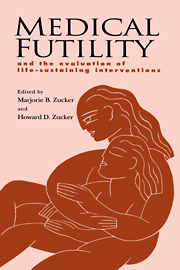Book contents
- Frontmatter
- Contents
- Preface
- Foreword
- Contributors
- 1 Medical futility: a useful concept?
- 2 Death with dignity?
- 3 Physicians and medical futility: experience in the critical care setting
- 4 Physicians and medical futility: experience in the setting of general medical care
- 5 Futility issues in pediatrics
- 6 Medical futility: a nursing home perspective
- 7 Alternative medicine and medical futility
- 8 How culture and religion affect attitudes toward medical futility
- 9 When religious beliefs and medical judgments conflict: civic polity and the social good
- 10 Conflict resolution: experience of consultation-liaison psychiatrists
- 11 Ethics committees and end-of-life decision making
- 12 The economics of futile interventions
- 13 Medical futility: a legal perspective
- 14 Professional and public community projects for developing medical futility guidelines
- 15 Community futility policies: the illusion of consensus?
- 16 Not quite the last word: scenarios and solutions
- Index of cited authors, cases, and statutes
- Subject index
11 - Ethics committees and end-of-life decision making
Published online by Cambridge University Press: 11 September 2009
- Frontmatter
- Contents
- Preface
- Foreword
- Contributors
- 1 Medical futility: a useful concept?
- 2 Death with dignity?
- 3 Physicians and medical futility: experience in the critical care setting
- 4 Physicians and medical futility: experience in the setting of general medical care
- 5 Futility issues in pediatrics
- 6 Medical futility: a nursing home perspective
- 7 Alternative medicine and medical futility
- 8 How culture and religion affect attitudes toward medical futility
- 9 When religious beliefs and medical judgments conflict: civic polity and the social good
- 10 Conflict resolution: experience of consultation-liaison psychiatrists
- 11 Ethics committees and end-of-life decision making
- 12 The economics of futile interventions
- 13 Medical futility: a legal perspective
- 14 Professional and public community projects for developing medical futility guidelines
- 15 Community futility policies: the illusion of consensus?
- 16 Not quite the last word: scenarios and solutions
- Index of cited authors, cases, and statutes
- Subject index
Summary
End-of-life decision making, an often sad and painful process, can be needlessly complicated by the perception that ethical dilemmas are an inevitable part of the process and necessarily result in a power struggle between patients, their families, and physicians. Ethical dilemmas do not arise in every end-of-life situation. More often, patients survive or die with little hint of an ethical problem. Typically, ethical dilemmas surface in that small number of cases in which there is genuine disagreement between the patient and the physician, between the family and the physician, among members of the family, or among members of the health care team who question the efficacy or appropriateness of continued aggressive treatment. In recent years, institutional ethics committees have increasingly become the forum for the resolution of these dilemmas. Therefore, the process of end-of-life decision making and the committee's role as consultant and mediator in the deliberation and resolution of these ethical dilemmas need to be better understood.
The role of ethics committees
In the context of clinical ethics, very few cases present true dilemmas. More often than not, the problem lies in poor communication between the parties, misinformation, denial of the seriousness of the illness, or reluctance to discuss the issues candidly. In some instances, ethical concerns need to be subordinated to prevailing law. For example, when a Jehovah's Witness refuses to accept blood transfusions or blood products, the law is clear that the patient's wishes must be respected.
- Type
- Chapter
- Information
- Medical FutilityAnd the Evaluation of Life-Sustaining Interventions, pp. 110 - 122Publisher: Cambridge University PressPrint publication year: 1997

